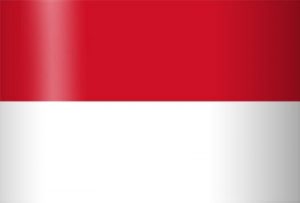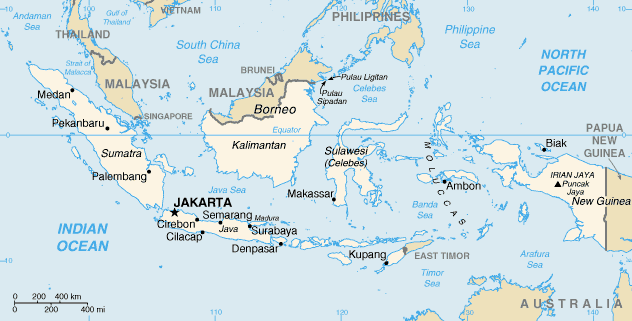
Indonesia
National implementation of the ASEAN Agreement on Disaster Management and Emergency Response (AADMER)
Overview of the DRM System
Indonesia has a Type D DRM System – Covers the full spectrum of disaster risk management: some elements of DRR, prevention, preparedness, early warning, mitigation, emergency management /response, and early recovery. Establishes specialist national institutions for DRM coordination and at least some local structures or roles. This is the most common type of DRM law found amongst countries with medium to high exposure to hazards that have adopted DRM laws since the mid 1990s. It is not necessarily based on a single law, but may be a mix of laws, regulations and assigned ministerial roles under executive government powers.
Legal framework
The DRM system is based on the Disaster Management Law 24/2007 (DM Law) and a series of regulations.
1. Government Regulation PP 8/2008
2. Government Regulation PP21/2008 Implementation of Disaster Control
3. Government Regulation PP22/2008 on Disaster Aid Financing and Management.
4. Government Regulation PP23/2008 on Participation of International Institutions and Foreign Non- Governmental Institutions in Disaster Management
5. BNPB Guideline 22/2010 on International assistance and Foreign NGOS (under review since 2014)
The 2008 regulations and 2010 Guideline concerning international assistance relate to international humanitarian assistance from international organizations and NGOs, not to interstate or ASEAN regional assistance.
A review of the DM Law was commenced in 2016, and in 2017 the Regional Representative Council (Dewan Perwakilan Daerah) endorsed a bill to amend the DM Law.
A draft National Disaster Response Framework 2017 was being discussed by different government agencies during 2017. It will become a Government regulation defining the different preparedness & response roles, which will cover all government ministries.
Key national institutions
The national disaster management agency, better known as the BNPB (for Badan Nasional Penanggulangan Bencana) is the main DRM agency.
Its role is further explained in elaborated in Government Regulation PP 8/2008. BNPB is directly accountable to the President, and is led by an appointed Head.
National committees are:
1. Disaster Management Steering Committee
2. Disaster Management Executive Committee.
Sub-national structures
Regional governments within Indonesia have general authority over disaster management in their regions (DM Law Art.9).
Regional Governments have established the Regional Disaster Management Agencies – BPBD – that are responsible for local level preparedness, response and recovery (DM Law Arts.18-25).
Funding and budget
The national government’s responsibility for disaster management under the DM Law includes allocating a sufficient disaster management budget from the National Budget and also making a budget allocation in the form of a ‘ready fund’ (DM Law Art. 6).
Regional governments are also required to budget for disaster management (DM Law Art.8).
Regulation pp 22/2008 on Disaster Aid Financing and Management specifies that disaster management funding is to come from national and regional government budgets and communities, and that governments are required to allocate sufficient for pre-disaster, disaster emergency response, and post-disaster stages (Arts. 4-5). It specifies that the National Government is to provide: disaster contingency fund; ready funds; and grant-patterned social assistance funds (DM Law Art. 5).
Integration of the AADMER and AHA Centre
The DM Law predates AADMER, and does not mention ASEAN. BNPB is the AHA Centre National Focal Point.
Provision on international and regional assistance
The DM Law and Government Regulation PP23/2008, relate to receiving assistance from international institutions and INGOs, not foreign governments.
Government Regulation PP23/2008 specifies that “In the event assistance for disaster management originates from a foreign state, the Head of BNPB must consult and coordinate with the Minister for foreign affairs. (Art. 17(1)).”
Facilitation of such international assistance is discretionary under Government Regulation PP23/2008: Under Art.13, international institutions or foreign non-governmental institution in disaster management activities, “may be granted facilitation” in accordance with law.

Laws, policies, plans and other resources
Laws, policies and plans
2007 Disaster Management Law
2008 Disaster Management Regulation
2008 National Agency Disaster Management Regulation
2008 Disaster Aid Financing and Management Regulation
2008 Participation of International Institutions and Foreign NGOs in Disaster Management Regulation
2010 BNPB Guideline 22/2010 on International assistance and Foreign NGOS (not yet available online / in English – see 2014 explanatory presentation in English)
2010-2015 National Disaster Plan (Indonesian version)
2015-2019 BNPB Strategic Plan (Indonesian version)
BNPB Special regulation on DRM Training (not yet available online / in English)
BNPB Regulation on Contingency Planning (not yet available online / in English)
National reports
2005 National Report for World Conference on Disaster Reduction
2009 National Report in Implementation of the Hyogo Framework for Action
2010 National Report on Implementation of the Hyogo Framework for Action
2012 National Report on Implementation of the Hyogo Framework for Action
2015 National Report on Implementation of the Hyogo Framework for Action
Reports and other sources
2005 GTZ Legal Framework for Disaster Management Particularly in the Field of Early Warning in Indonesia
2005 IFRC Indonesia Laws, Policies, Planning and Practices on International Disaster Response
2006 IFRC Legal Issues from the International Response to the Tsunami in Indonesia
2011 HI/ASB Mainstreaming Disability into Disaster Risk Management Initiatives in Indonesia and Philippines
2014 IFRC International Disaster Response Law (IDRL) in Indonesia
2015 CFE Disaster Management Reference Handbook Indonesia
2017 IFRC Strengthening Law and Disaster Risk Reduction in Indonesia
![]()

